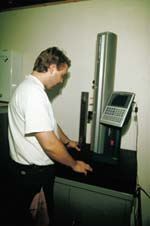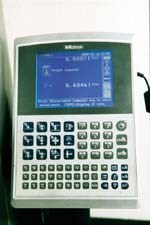Job Shop Solves 2D Measurement Problem With Single-Axis Height Gage
Job shops are always trying to satisfy customers who are in a hurry. Sometimes these customers provide demanding or faulty specifications and then claim that a job isn't done right.
Share





Job shops are always trying to satisfy customers who are in a hurry. Sometimes these customers provide demanding or faulty specifications and then claim that a job isn't done right. This is what happened at CJ's Machining Inc. (Anderson, South Carolina). It was asked to machine components to tolerances tighter than its inspection procedures could handle.
CJ's performs CNC milling and turning primarily for automotive part manufacturers and pharmaceutical process applications. "Sometimes we repair, sometimes we rebuild, sometimes we make replacement parts for inventory," says company owner Jerry Vickery.
Just about all of CJ's customers are big, tough to please and in a hurry. "Most of the parts they ask us to make are not that difficult—in the tolerance range of ±0.005 inch. But every once in a while a job comes along that is much more demanding," says Mr. Vickery.
This happened recently when one of CJ's major customers asked it to machine lubricating components for an industrial process machinery job. The order consisted of one lot of 30 pieces, each 22 ½ by 3 by 2 inches.
Each piece had 30 holes spaced at irregular intervals. The holes had to be spaced very precisely (± 0.0005 inch absolute tolerance) in relation to each other to prevent leakage of the lubricant during operation.
For this job, CJ's operators would ordinarily use a one-axis manual height gage equipped with gage pins or dial indicators. Dimensional measurements using the existing equipment were not accurate enough. Trying to make accurate measurements consumed a lot of time. "Manual measurement in a case like this is no more accurate than the person doing it. There was no room for accumulation of error. We have good machinists, but there was a lot of room for error on this job," says Mr. Vickery.
Errors in manual inspection can come from three sources. Measurement errors result from variations in torque and pressure where tools or probes contact the workpiece. Reading and transcription errors result from human interaction with the data generated by the measurement device.
On this job, Mr. Vickery says the source of the accumulation error was an inability to measure the relative positions of the many holes in the workpiece. They had to be positioned longitudinally and transversely, and they were irregularly positioned in both axes. Use of the manual one-axis gage resulted in registration errors. In other words, the size and position of the holes could not be verified in both absolute and relative terms.
"We wanted to make sure the parts would pass the customer's incoming inspection," says Mr. Vickery. "At first we thought we could just duplicate what the customer was doing. They had a measuring system that I would estimate cost them $15,000. That was more than we could afford." So Mr. Vickery did some searching and discovered the Mitutoyo LH600 single-axis linear height measuring system from Mitutoyo (Aurora, Illinois) for less than that. "Although it's called ‘single-axis,' we found that it could be used to accurately measure parts in two axes for the price of one," he adds.
With the switch to the Mitutoyo linear height measuring equipment, CJ's operator could measure to the edge of a hole and retain the measurement in memory. Then the machine calculates the size and center of the hole, actuated by a touch-screen "center finder" feature. Proceeding in this manner from one hole to the next, and retaining all the dimensions in memory, the machine develops an accurate 2D memory of the part.
CJ's Machining was able to set up and operate the LH600 immediately. Even without training, the company used it to perform 2D measurements simply and accurately.
The gage uses a pneumatic drive to achieve high speeds while maintaining accuracy. It can be used to measure height, circle diameter, distance, perpendicularity and straightness, and it provides for tolerance setting and judgment. It measures parts up to 38 inches in any dimension.
Once he had installed the new equipment, Mr. Vickery quickly established the correct position for the holes on the lubricating assembly. The 30 pieces were fabricated with holes spaced correctly, to a tolerance of 0.0005 inch non-accumulative. They passed the customer's incoming inspection without a hitch.
CJ's stores the sequence of measurement steps and values for a particular part on an external floppy drive. When the part is brought for inspection, the probe moves through a pre-programmed routine to measure it.
The semi-automatic measuring run is actuated by a single key. Flipping the key runs the LH600 through the programmed measurements to the last result display. This eliminates intervening key operations (which may be quite complex) and allows the operator to concentrate on inspection.
CJ's Machining adopted the standard practice whenever possible of programming the part inspections in advance. This enabled it to save at least an hour on every job coming through the shop, and sometimes more. But above all, the LH600 introduced a higher standard of accuracy to dimensional inspection. It measures at an accuracy of (2+L/600) micrometer with 0.1 micrometer/0.5 micrometer resolution/repeatability.
After several weeks of trouble-free inspection measurement, a Mitutoyo representative came to the shop and trained CJ's employees on additional details of the system's operation.
"It shows little icons on the display explaining what the various measurements are," says Mr. Vickery. "You simply insert the probe into the feature you want to measure, touch the icon with your finger, and the machine gives you the dimension."
The simplicity of the LH600 solution started to pay off right away and continued as CJ's machinists found new ways to apply it. Jobs that typically took 45 minutes to measure using a conventional one-axis manual height gage could be finished in 10 seconds. Using the equipment to verify tolerances and check the position of features on parts now typically saves about an hour on every job. It paid for itself after measuring about 100 jobs.
Because more jobs are completed right the first time, there are fewer remakes. CJ's is realizing higher machine utilization throughout the shop. The business has been able to handle more work without adding more machinery or hiring additional employees.
Furthermore, the LH600 permits RS-232C data output. This allows CJ's Machining to evaluate and verify measurement data using an external PC loaded with SPC software.
Related Content
Parts and Programs: Setup for Success
Tips for program and work setups that can simplify adjustments and troubleshooting.
Read MoreHow to Evaluate Measurement Uncertainty
Manufacturing and measurement are closely coupled. An important consideration for the use of measurement results is the associated measurement uncertainty. This article describes common metrology terms and provides an example uncertainty analysis.
Read MoreHow to Calibrate Gages and Certify Calibration Programs
Tips for establishing and maintaining a regular gage calibration program.
Read MoreChoosing the Correct Gage Type for Groove Inspection
Grooves play a critical functional role for seal rings and retainer rings, so good gaging practices are a must.
Read MoreRead Next
Registration Now Open for the Precision Machining Technology Show (PMTS) 2025
The precision machining industry’s premier event returns to Cleveland, OH, April 1-3.
Read More5 Rules of Thumb for Buying CNC Machine Tools
Use these tips to carefully plan your machine tool purchases and to avoid regretting your decision later.
Read MoreBuilding Out a Foundation for Student Machinists
Autodesk and Haas have teamed up to produce an introductory course for students that covers the basics of CAD, CAM and CNC while providing them with a portfolio part.
Read More




















.jpg;maxWidth=300;quality=90)


















